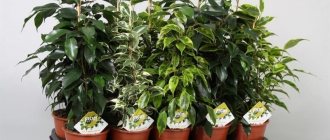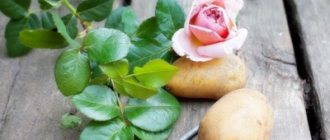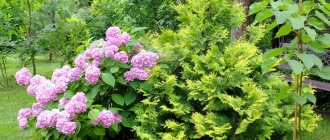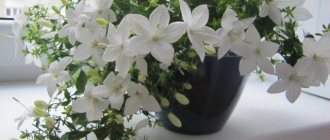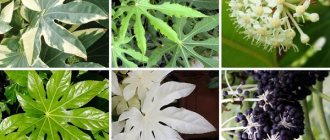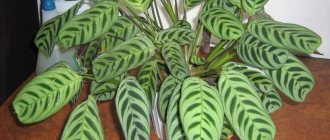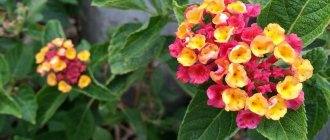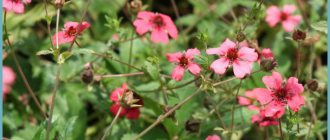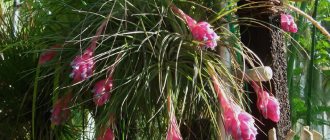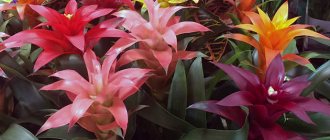When is the best time to propagate Sansevieria?
Spring is the most favorable time of year for the propagation of any plant. Sansevieria is no exception. In spring, all metabolic processes in it begin to occur at an accelerated pace, so the rooting process will be faster and more favorable.
It should be noted that mother-in-law’s tongue is such an unpretentious plant that, in principle, it can be successfully propagated at any time of the year. Especially if the reason for propagation was emergency measures to save the dying sansevieria: the root system began to rot, the flower fell and broke, etc.
In winter, propagation is not recommended, since it is difficult to provide the new plant with the necessary conditions for its rooting, and metabolic processes are slowed down: the plant will be sick for a long time, and it is possible that it will not take root at all.
How to protect against pests
Not a single indoor or garden plant is protected from pest attacks. And you need to fight them so as not to lose your favorite flower.
- Sansevieria tolerates partial shade well, but open sun causes the color to fade and the design to become less interesting.
- Waterlogging of the soil. The plant is able to store water in its hard leaves. Therefore, excess watering, especially in the autumn and winter months, leads to rotting of the roots and death of the plant. Overwatering causes rot on the leaves. In this case, they must be carefully cut off and the flower must be transplanted into a new pot.
- Spider mite. It also quite often settles on indoor plants and in particular on sansevieria. In this case, the leaf becomes sluggish and gradually loses color. He turns pale and dies. To rid the plant of this pest, you need to use special preparations. Fortunately, there are a lot of them today.
- If the leaf darkens, it means thrips colonies have worked here. Wash the plant in the shower and treat with insecticide.
- Sometimes you can see the leaves turning yellow. And many gardeners decide that there is not enough watering. In fact, this indicates a mealybug infestation.
These are the main diseases that occur in this indoor flower. It should be noted that the flower gets sick much less often than many of its decorative counterparts. Therefore, in most cases, the grower does not pay attention to it at all, until the moment the situation becomes critical. Of course this is a mistake. All your plantings need daily inspection, care and attention.
Soil preparation
The soil for planting sansevieria should be loose, permeable, and not heavy.
It is best to use ready-made soil substrate for succulents, purchased at a flower shop. You can prepare the soil mixture for pike tail yourself:
- The composition should include the following components: leaf, turf soil, humus, sand in a ratio of 2:2:1:1, you can add a little charcoal.
- Another recipe: mix 4 parts turf and 2 parts leaf soil, 1 part sand. You can also add some organic fertilizers, such as peat.
Which pot is suitable?
Material
For sansevieria, a clay or ceramic pot is considered the most suitable. Clay is an environmentally friendly substance, has excellent breathability, thereby providing air access to the roots, and absorbs moisture well, providing additional drainage. Pots made of clay and ceramics are quite stable, and this is an important factor for such a tall plant as mother-in-law’s tongue. In addition, containers made of clay and ceramics are durable; they can withstand the pressure of the powerful roots of Sansevieria on the walls.
Attention! The pot must have holes in the bottom to drain excess water, and the bottom of the pot must be covered with a layer of drainage, which can be expanded clay, broken brick, or pebbles.
Size
Mother-in-law's tongue feels most comfortable in small containers: in a cramped position the plant produces flowers more readily.
It is important that the pot is shallow but wide, as the roots of this plant grow wide.
Varieties
2.1. Sansevieria Hanni - Sansevieria Hahnii
Ruellia quality care and photos of popular varieties
Low-growing, short-leaved plants that form basal rosettes of spirally arranged thick, fleshy, often striped, triangular leaves. Plants are characterized by dense leaf arrangement. The color of the leaves varies and can be green with all sorts of specks and stripes - both longitudinal and transverse. Yellow-striped variations look extremely impressive. The flowers are creamy-brown, with a sweetish aroma, but flowering rarely occurs indoors. Due to its compact size and unpretentiousness to lighting (Sansevieria Hanni grows well under artificial lighting), this variety is very popular among gardeners.
You may also be interested in:
- Alstroemeria - flower photo, planting and care, cultivation in open ground and at home, description, varieties, soil composition for keeping homemade alstroemeria in a pot
- Young - photo, planting and care in open ground, varieties of stone roses, growing a flower at home, flowering time of the plant, composition of soil for keeping in a pot, description of the plant
- Saintpaulia - photo, violet varieties, home care, plant propagation, soil for growing indoor flowers, diseases and pests, replanting, fertilizer, watering
- Verbena - photo of a flower, planting and care in open ground, growing seedlings, plant in a flowerbed, medicinal properties, description, keeping in a pot and in flowerpots, height
- Monarda - photo, planting and care in open ground, medicinal properties of the flower, description of the plant, growing from seeds, use of essential oil, varieties, caring for perennials at home, flowering time
2.2.Sansevieria trifasciata
This is a large evergreen perennial plant with high basal leaves (up to 1 m in height). With proper care, this variety will last for many years. The leaves are thick, sword-shaped, pointed, dark green in color with gray-green horizontal stripes. In spring or summer, adult specimens may produce small, fragrant, greenish-white, fragrant flowers, but this phenomenon is rare in indoor culture.
Sansevieria three-lane also includes a very beautiful variety - Sansevieria Laurentii - a tall, narrow-leaved plant with spectacular variegated leaves bordered with a yellow stripe. Transverse dark, almost black stripes are scattered across the main green background in the center of the leaves, and along the edges of the leaf blades there is a wide yellowish border.
2.3. Cylindrical Sansevieria - Sansevieria cylindrica
An interesting species, with tall, sometimes gracefully arched, rounded, tubular leaves of a dark green color with silvery transverse stripes. The leaves reach a diameter of 3 cm, and grow up to 1 - 2 m in length. In the summer months, the plant throws out tall flower stalks, at the top of which there is an inflorescence consisting of small greenish-white flowers, and this variety blooms at home much more readily than others . Often the beautiful leaves of cylindrical sansevieria are braided.
2.4.Sansevieria Futura Superba
A small species, often not exceeding 30 cm in height. Plants form a basal rosette of thick, oblong leaves arranged in a spiral. The main tone of the leaf plates is silvery-green with transverse dark stripes. The edges of the leaves are painted white or yellowish.
2.5.Sansevieria Moonshine
The name of the variety - Moonlight - speaks for itself - the leaves of this plant are colored silver-green with barely noticeable dark transverse thin stripes. Along the edge of the leaf blades there is a dark green thin stripe. The thick leaves of this sansevieria reach a width of 10 cm and a length of 60 cm.
2.6.Sansevieria Black Dragon - Sansevieria Black Dragon
Low, almost dwarf plants up to 30 cm in height with triangular leaves collected spirally into leaf rosettes. The main feature of this plant is its beautiful dark green, almost black, glossy leaves.
2.7.Sansevieria Kirkii
Very spectacular decorative foliage plants with large sword-shaped leaves reaching a height of 90 cm. A distinctive feature of the species is the corrugated edges of the leaf plates and the unusual, attractive bright color of the leaves. The surface of the leaves seems to be covered with a bronze patina, and the edges of the leaves have pink and white thin stripes.
You might also be interested in:
Chlorophytum
Dracaena
Aspidistra
Ficus
What nuances should be taken into account?
The Sansevieria leaf is cut perpendicular to the veins into pieces of 5–15 cm each. It is necessary to note or remember where each fragment is top and where is bottom. When rooting, immerse the cutting in water or soil only with the lower part, taking into account the direction of movement of the plant juices. If this nuance is not taken into account, the cutting will not give roots.
The number of leaves cut depends on how many copies of young plants need to be obtained. A larger number of leaves increases the likelihood that the cutting will be successful: even if some petioles do not take root, the bulk will still sprout roots.
Planting in water at home
- Prepare everything you need: a container with water, sharp scissors, a Sansevieria leaf, the drug “Kornevin”.
- Cut the sheet into several fragments, mark the top and bottom of each segment (you can use a simple ballpoint pen).
- Add a little Kornevin preparation to a container (preferably transparent for better observation of the condition of the roots being released) with water.
- Place each of the pike tail petioles into water, strictly observing the rule: only the lower part is immersed in the liquid.
- After each of the fragments has cast out its roots, they should be planted in pots with soil.
Reference! On average, rooting of mother-in-law's tongue by the petiole in water occurs within 2 to 3 months.
Sansevieria transplant
Features of caring for chamelacium at home
Replanting sansevieria is necessary every two years, and it is better to do it in the spring. The pot for sansevieria should be wide and not deep, because the roots of the flower grow wide. The soil must be fertile, you can add a little sand, humus soil or peat, and the plant also needs good drainage. The most important thing when replanting a flower is not to damage the leaves; if you break them, the sansevieria will stop growing.
Such a seemingly unpretentious flower as Sansevieria also has diseases. If the leaves are covered with yellow spots, it means there is too much sun; if there is too much moisture, the leaves will rot. But if the disease has already occurred, do not be upset, cut off the diseased leaf and use it to propagate sansevieria. There are also pests that cause Sansevieria disease, such as mealybugs or mites, and they need to be controlled with a special insecticide.
It is necessary to water sansevieria moderately, without flooding the flower; from one watering to the next, the soil should dry out. And in winter, watering sansevieria should be reduced to 1-2 per month.
You already know how to care for sansevieria; the most important thing is not to overwater the flower or take it out into the cold. Wipe the leaves with a soft cloth, this way you will rid the flower of dust, and under no circumstances spray water, Sansevieria does not like humidity. If you follow the basic rules for maintaining this unpretentious flower, it will delight you with its blooms, delicate aroma and clean air in your home.
Sansevieria contains a number of biologically active substances, but the most important of them for humans are saponins - highly toxic substances that, when used properly, can bring great benefits.
In traditional medicine, saponins are used in the production of laxatives, choleretic, expectorants, and anti-inflammatory drugs. In folk
In medicine, sansevieria is used for cystitis and adnexitis, otitis, and inflammation of the throat and oral cavity. It helps increase immunity, stress resistance, and improve the general condition of the body. You can use it for cuts and bleeding. For scratches and other shallow damage to the skin, it is recommended to apply a sansevieria leaf with the side from which the skin was previously removed to the affected area. The plant, like plantain, will disinfect and stop bleeding.
Saponins are glycosides of plant origin with surfactant and foaming properties. They are practiced in cosmetology in the manufacture of detergents such as shampoos, liquid soap, etc.
It is not recommended to use sansevieria in treatment during pregnancy, since it is believed that the substances contained in this plant have abortifacient properties.
Sansevieria tincture for genitourinary infections
Ingredients: 1 sansevieria leaf about 25 cm long, 200 ml of vodka.
Method of preparation: Grind the Sansevieria leaf, pour in vodka and leave for 2-3 weeks in a cool place protected from light. Strain.
Directions for use: take 1 tbsp. morning and evening after meals for 2 weeks.
Note: recommended for cystitis, adnexitis.
Sansevieria decoction for infectious diseases of the gastrointestinal tract
Ingredients: 2 sansevieria leaves about 25 cm long, 1.5 liters of water.
Method of preparation: chop sansevieria leaves, add water, boil for several minutes, then leave for 3 hours, strain.
Directions for use: do an enema with the resulting solution once a day.
Sansevieria juice for otitis media
Ingredients: 1 sansevieria leaf, about 25 cm long.
Method of preparation: squeeze the juice from the plant, heat it slightly.
Directions for use: instill sansevieria juice into the sore ear 3 times a day.
Sansevieria infusion for colds
Ingredients: sansevieria root about 15 cm long, 500 ml of water.
Method of preparation: chop the sansevieria root, add hot water, leave for several hours, strain.
Directions for use: take 1 tbsp. l. 3 times a day during treatment of ARVI and influenza.
How to plant in the ground?
- Prepare all the tools and what will be necessary for planting: a container (preferably flat and wide), soil (perlite, sand), the Kornevin preparation, a spatula, scissors, a watering can with water (about what the soil for sansevieria should be, we talked about here).
- Cut the sheet into several parts, mark the top and bottom of each segment (you can use a simple ballpoint pen).
- The resulting cuttings should be slightly dried for several hours.
- Pay attention to the fragments, strictly follow the basic rule: the lower part of the cutting is buried in the ground.
- Each lower part of the fragments should be treated with the drug “Kornevin”.
- Pour sand or other filler into the container and make grooves about 3 cm long in it.
Plant cuttings in each of the grooves, deepening each one at an angle of 45 degrees by a third (planting depth is about 1.5 - 2 cm). The distance between cuttings is 2–3 cm.- To protect against diseases, cuttings need to be sprayed with a fungicide (read about what diseases and pests can destroy sansevieria and how to help the affected plant).
- As soon as the roots appear, the plant should be transplanted into an individual pot with soil (read more about the rules for transplanting sansevieria here).
Rooting usually occurs after 1.5 - 2 months. And after another 7–8 months, the sansevieria planted in the ground will produce new young shoots.
It is not advisable to make a greenhouse, since high humidity in it can contribute to the rotting of the cuttings.
Transplantation and propagation of sansevieria
The flower propagates in three ways: part of the leaf, side shoots, divided rhizome.
In the first method, the leaf is cut into small pieces and the cut is dried. And after treatment with Kornevin, they are planted in prepared soil.
In the second method, the side shoots are carefully separated and transplanted into a separate container.
The third method is the most optimal. The rhizome is divided into parts with a sharp knife. It is necessary to ensure that the growth point is preserved in each of them. Then the separated rhizomes are planted in a pot with a sandy substrate. Watering periodically, wait for rooting for two weeks. After the first roots appear, the plant is transferred to a container with prepared soil.
Cuckoo's tail is best planted in thick-walled ceramic containers.
Relocating a pike tail to a flowerbed in warm weather
Sansevieria feels comfortable in open ground. It grows well both in the sun and in the shade, does not require frequent replanting, tolerates drafts, rare and even very rare watering. Some flower growers specifically, as soon as the threat of spring frosts disappears, transplant the plant into a flowerbed so that it “gets healthier” there: the leaves gain strength, the color becomes brighter, and a flower stalk is finally released.
How to do this:
- Lightly dig up the soil in the flowerbed, thereby saturating it with oxygen. You can add a little sand, peat, humus to the soil.
- Dig a hole in the ground, the depth of which will correspond to the height of the pot in which the sansevieria grew.
- Water the hole and the flower in the pot.
- Carefully remove the plant along with the earthen lump and, without shaking off the substrate, transfer it into the hole.
- Fill the remaining voids with soil, pressing it down a little.
- During the summer, it is systematically necessary to loosen the soil around the pike tail, apply fertilizers, and water as the top layer of soil dries out.
- As soon as the temperature drops to +17C - +18C with the onset of autumn, the plant must be watered abundantly.
- Carefully dig the sansevieria out of the ground: most likely, the root system has grown greatly over the summer, so the flower will need to be replanted in a larger pot.
- Planting in a pot is done in the usual way.
- The flower in a pot is first brought onto the veranda or balcony, and after 3 days - into the apartment or house.
Is it possible to keep a flower at home according to Feng Shui?
According to the teachings of Feng Shui, sansevieria has powerful and strong energy, so it is recommended to place it only in spacious, large rooms.
In order for flowers to bring only joy and harmony, you must follow simple rules when placing them:
- they cannot be placed between two doors
- Do not place house plants in a straight line between the window and the door
- an energetically strong plant should be placed at a distance of at least a meter from the workplace or recreation area
To ensure that the pike tail brings only benefits and joy, take care of it, monitor the health of the flower, and replant it in a timely manner.
The main thing is that the owner likes the flower, then it will show its positive qualities to the fullest.
We recommend watching a video about Sansevieria:
This flower is known in the gardening world as Sansevieria. Among fans it is also called “pike tail”. This plant is considered medicinal and requires good care. Photos of the plant can be viewed on the Internet, on sites dedicated to medicinal plants.
It must be said that the “pike tail” became the source of the birth of a variety of signs. Some of them can be explained by the elementary laws of chemistry. It is impossible to explain why other reasons appeared.
Of course, everyone who grows “pike tail” and cares for it at home asks the question: is this plant beneficial, or does it harm its environment?
Photo
Look how beautiful the pike tail looks in the flowerbed:
Conditions for the flower
Sansevieria can easily tolerate low light, but it is not recommended to keep it in the far corner of the room all the time. In order for a flower to look beautiful, it needs light. For moderate sunbathing, he will respond with gratitude in the form of succulent leaves of bright colors. But Sansevieria does not like direct rays or long daylight hours.
As for the air temperature, the pike tail is even more unpretentious than with lighting. The flower calmly tolerates daily changes and sudden temperature changes.
Lighting for sansevieria should be moderate
Seasonal conditions: air temperature, humidity, lighting - table
| Condition | Autumn and winter | Spring and summer |
| Air temperature | You should stick to +14–16°C, higher temperatures are acceptable. But it should not fall below +10°C. | It is recommended to monitor the temperature increase, optimally not higher than +26°C. |
| Humidity level | Moderate. Sansevieria does not require spraying. | |
| Lighting | Bright and diffused light, partial shade is also suitable. Sansevieria can grow even in the shade. The best location is an east or west window. | Shade the plant in the middle of the day. |
Caring for young cuttings
If Sansevieria was propagated by dividing the leaf, then after immersing the cuttings in the soil, they need to be watered (you can learn more about the methods of propagating “pike tail” here). Then you need to water the future plants moderately, remembering that mother-in-law’s tongue is a succulent. The recommended temperature for keeping a container with petioles is +20C – +22C. It is at this temperature that rooting occurs faster and more efficiently. Sansevieria loves a lot of diffused light, but you should avoid direct sunlight on the petioles.
Description
Sansevieria (from Latin Sansevieria) is a genus from the asparagus family, which includes about 60 species. These evergreen stemless plants grow in savannas, deserts and semi-deserts of Asia and Africa. It is popular among flower growers around the world and evokes many associations, which is why it has been given various poetic names:
- pike tail,
- leopard lily,
- mother-in-law's tongue,
- cuckoo tail,
- indian sword,
- Snake skin,
- African hemp,
- devil's tongue
- There are variants of the Latin name: sanseviera, sansevieria, sanseviera.
Mother-in-law's tongue is suitable for landscaping both apartments and offices.
- The main decorative value of sansevieria is its leaves.
- They have a lanceolate shape and extend upward from a powerful root.
- The pointed leaves can reach a height of 1 m, in some varieties - higher.
- The color of the leaves is dark green or brown; varieties with yellow and silver leaves have been bred.
- Depending on the variety, there may be decorations - edging, transverse or vertical stripes.
In early spring, Sansevieria begins to bloom. It lasts on average 2 weeks. The flower produces a spike-shaped arrow on which small white flowers are located. An interesting feature: the buds open late in the evening and last all night.
At this time, a subtle and delicate aroma reminiscent of vanilla is felt. The fruit of the plant is a berry with a small number of seeds, but at home it rarely sets.
mschistota.ru
What to do if the plant does not take root?
Despite the fact that sansevieria is very unpretentious in care, sometimes the rooted segments do not take root. What is the reason? As a rule, excessive watering is to blame for this, as a result of which the tip of the cutting may rot after planting. You can try to correct the situation by doing the following: remove the petiole from the ground, cut off the rotten tip, wither it in the open air, treat it with “Kornevin” and root again. You should also adjust the watering schedule so that a similar situation does not happen again.
Even a novice gardener can propagate his favorite plant in this way. But it is important not to forget about proper care of sansevieria, so that young and old plants can decorate the interior of an apartment or the design of a flower bed with their original shape for many years to come.
Benefits and harms
Beneficial features
Our grandmothers loved “Pike Tail” not only for its unusual appearance and unpretentiousness.
- Popular rumor said that this flower purifies the air, absorbs unpleasant odors, and increases efficiency.
- True, they also attributed to him not very “good” qualities, for which they called him “Mother-in-law’s tongue”: in scandals, quarrels in the family, emotional tension. It was quite rightly noted that in an unfavorable emotional atmosphere, Sansevieria grows much better than in houses where everything is fine.
The answer to the question of where is the truth and where are the myths was given by scientists and Chinese Feng Shui experts. The medicinal properties of “Mother-in-Law’s Tongue” to purify the air thanks to the organic compounds in its composition, to release enormous amounts of oxygen for such a small plant, and to disinfect the air have been proven through numerous studies.
Fans of the teachings of Feng Shui attribute simply magical healing properties to this plant:
- absorption of negative energy,
- malice,
- aggression,
- rudeness,
- as well as radiation from computers and TVs.
The plant is a warrior that survives in the most difficult conditions, the leaves of which resemble a sword, help strengthen the spirit, learn new things, resist troubles, give efficiency and strength.
Sansevieria is used in cosmetology, is included in detergents, and preparations with substances obtained from this plant are used in traditional medicine to treat inflammation of the oral cavity, as an expectorant and laxative.
What is the treatment with Sansevieria?
When indoors, this plant helps people suffering from weather dependence, stabilizing blood pressure, increasing immunity, and speeding up recovery from colds. The juice, like aloe juice, is a proven anti-inflammatory agent for otitis media, inflammation of the skin, accelerates wound healing, relieves itching, and also has a mild analgesic effect. Sansevieria will help with intestinal diseases, parasitosis, and gynecological diseases.
Indications for use
If stress is a common occurrence in your life, get yourself this tireless assistant at home and at work. It will help you normalize the situation without demanding anything in return.
- The skin of the leaves is used for burns and wounds.
- Sansevieria decoctions are useful for infectious diseases of the genitourinary system and cystitis. They are also used in the treatment of dermatitis, scabies and worm infections.
- A decoction of the root increases performance.
- The juice helps with ear pain, wounds and burns.
- Lotions made from crushed leaves accelerate the healing of ulcers and inflammations.
- The smell of sansevieria helps with headaches. These properties of the “pike tail” are also preserved in the dry leaves of the plant, which are placed under the pillow or burned in the room where the sick person is.
- Blooming Sansevieria is not a common occurrence, but if you are lucky, a few sessions of aromatherapy will be a grateful gift from the flower, which smells like vanilla and treats respiratory tract infections.
Harm to the plant
Is Pike Tail poisonous?
Saponins, for which Sansevieria is valued, become poisonous in large doses
In medicine they are used with caution, not recommended for pregnant women and children. There is no need to be afraid to grow this plant; it is only dangerous when consumed in its pure form orally.
If this miracle flower has settled in your home, do not forget about its ability to cause harm.
- It is believed that the too powerful energy of the “Pike Tail” can interfere with sleep, so it should not be placed in children’s rooms or bedrooms.
- Beneficial when applied to the skin, the juice becomes a strong poison.
- In cats that love to gnaw all the flowers in the house due to vitamin deficiency, Sansevieria can cause dermatitis, intestinal upset, and vomiting.
- A dog that eats a casting of a flower will also feel sick and vomit.
Signs of Pike Tail Poisoning
Burning and sore throat, nausea, vomiting, diarrhea, profuse salivation - these symptoms accompany Pike Tail poisoning. A reasonable adult is unlikely to decide to chew a striped green sans leaf, but a child may well do it. The consequences of such an act are extremely painful and unpleasant, the burning and drooling alone are worth it!
Precautionary measures
- Carry out all flower care work with gloves, making sure that the juice does not get into your eyes.
- Immediately remove the cut leaves and parts of the roots into the trash bin or destroy them.
- If you haven’t kept an eye on your baby or pet, at the first sign of poisoning, try to induce vomiting, then give activated charcoal and call a specialist.
- Do not keep Sansevieria in rooms where toddlers sleep and play.
selo.guru
